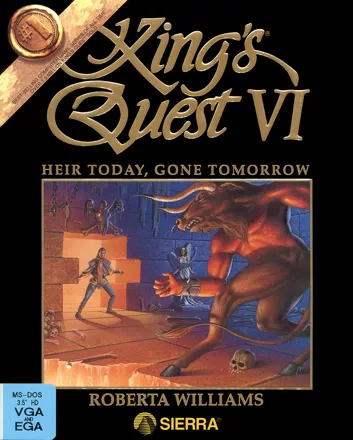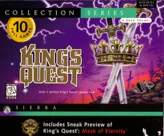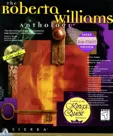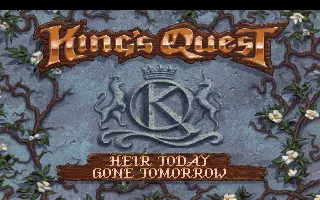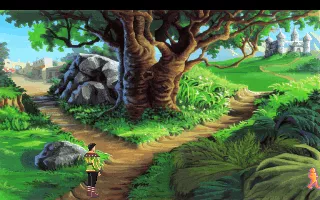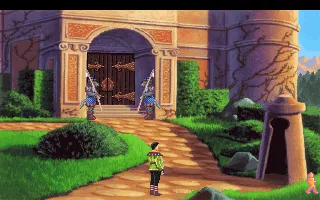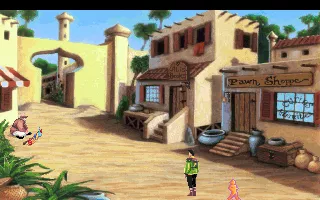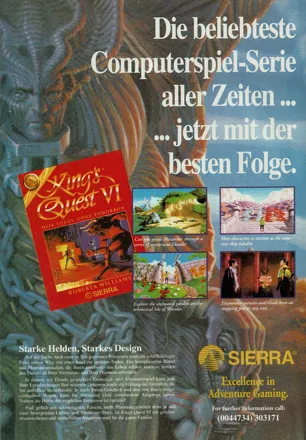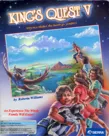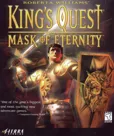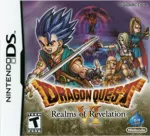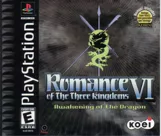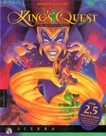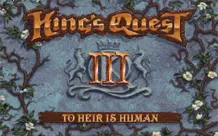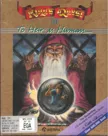King's Quest VI: Heir Today, Gone Tomorrow
Description official descriptions
For months Prince Alexander of Daventry has shut himself away from the world, thinking only of Princess Cassima, who he met while imprisoned in the previous game. Eventually he can take it no longer, and he hires a ship to search for the Land of the Green Isles located on the edge of the world. After months of searching he finally sets sight upon the island kingdom, only for a freak storm to strike the ship, destroying it and leaving him the only survivor. His troubles are far from over, however, as he soon finds out that the King and Queen have passed away, the Greens Isles are on the brink of war, and his beloved Princess Cassima may even be held prisoner by the royal vizier.
Like its predecessors in the series, King's Quest VI: Heir Today, Gone Tomorrow is a third-person puzzle-solving adventure game. For Alexander to save the Isles, he must travel between the Land's four magical islands, each based on myth and fables, and encounter people and strange beasts that will either help or hinder him. Alexander must be careful as well, because, as with all the King's Quest games, poor choices or missteps will often prove fatal for the Prince. Puzzles are solved linearly, although late in the game there are two completely different paths to take to reach the final confrontation. Like the previous game, actions are performed using a point-and-click interface with icons that represent verbs ("walk", "examine", "use", "talk", etc.).
The CD-ROM version of the game includes both DOS and Windows versions, full speech, a pre-rendered introduction, and the Girl in the Tower theme song.
Spellings
- 國王密使 VI:希望之旅 - Traditional Chinese spelling
Groups +
Screenshots
Promos
Credits (DOS version)
39 People (37 developers, 2 thanks) · View all
| Written & Designed by | |
| Produced by | |
| Directed by | |
| Art Designer | |
| Composer | |
| Text & Dialogue | |
| Senior Artist | |
| Team Artist | |
| Senior Programmer | |
| Sound | |
| Team Programmer | |
| Additional Music | |
| Quality Assurance | |
| Additional Sound Effects | |
| [ full credits ] | |
Reviews
Critics
Average score: 83% (based on 27 ratings)
Players
Average score: 4.0 out of 5 (based on 165 ratings with 11 reviews)
A great adventure from Sierra and one of the best IF not the best Kings Quest games!
The Good
The good points
The Graphics are highly detailed for their time and are filled with lush color.
The voice acting on the cd version is actually VERY well done compared to other voice acted games of the time. Kudos for sierra for giving a good cast!
Some puzzles are particularly devious. The cliffs of logic were rather tough and took time since you had to actually use that manual for something!
Alexander is a great main character and has quite a bit of intellect by him. You gotta admire the courage he has to meet a princess in a basically unknown land.
The Interface is great and easy to use. Out of all the interfaces sierra has this is my favorite.
The land of the green isles is varied and quite big for a adventure.
The game has TWO different endings!
The Bad
The game once beaten is very short and can be beat in about 20-30 minutes once you memorize all the puzzles and use the fastest route to beat the game.
the game does not have much replay value after you beat it and get both endings though you may want to replay it every few years to forget the puzzles and get the gameplay through again.
The Catacombs maze is rather annoying.
The Bottom Line
First a little backstory on how I came across this game
It was a beautiful day in 1996 when I was out getting the first family computer! Back in those days before I could get a computer of my own I was out in a computer expo and there I saw it! The cd version of Kings Quest VI Heir Today gone Tomorrow in a box brand new for four dollars! This being my first computer game I was completely awe struck at the colorful graphics and the great voice acting.
Now that the past is gone I still have this game and manual and pull it out every once in a while to relive the land of the green isles. The game as you know is a Sierra adventure game and goes with every other click game sierra made. You know Gabriel Knight, Eco Quest, Leisure Suit Larry, Police Quest, Quest for Glory and so forth. Great stuff.
If you love adventure games get this game which is a pinnacle of Sierra gaming! The best in my opinion of the kings quest series!
DOS · by Mr. Huh (105) · 2004
Ahh ... Romance ... ain't it grand?
The Good
There were 2 years separating this game and its predecessor, King's Quest 5, a game which was criticized by many, even though it was one of the first to introduce a mouse-driven interface. Because of all that criticism, it's no wonder Sierra decided to go "back" to what had been successful in the past - somewhat anyway.
The graphics, as others pointed out, are stunning. I found the music lovely and so very romantic. (We females tend to like mushy love stories, ya know.) I simply adore plots about heroes saving damsels in distress. This hero is handsome and the princess is beautiful. What good looking children they will make! And ... oooh ... the ending - you must see the ~kiss~. I remember getting goosebumps watching it. I was satisfied knowing they would live "happily ever after."
The Bad
I played KQ6 when it was new, so it is hard to remember. I don't recall anything about it I didn't like.
The Bottom Line
If you long for a classic tale of love and honor, this game's for you! This is the last game in the series that retained the original look and feel of the originals. Recommended for adults and children alike, it would make a fine addition to any collection.
DOS · by Jeanne (75837) · 2001
This is possibly the best Kings Quest adventure in the series.
The Good
This game is part of the great Kings Quest series, all great adventures. In my opinion, this game is the best one of all. It has many puzzles that can be solved in different ways, one way easier than the other. But choosing the hard way over the easy will give you the best ending. Meet a lot of cool people in a fantasy world divided into several islands. Overall, this game is very cool and it will keep you playing, and you won't be stuck too long because of the multiple puzzle solutions.
The Bad
The story was a little unoriginal. A prince looking for his great love who is locked up in a tower by the evil wizard who wants to marry her to gain control over the land. But the way it is brought in this game, it doesn't matter much. Another thing that is a little anoying is the unexpected deaths. Example : You walk in a maze, you enter a passage (You cannot see where it will lead) and at the end of this passage, there's a hole in the ground, you fall in and are dead.
The Bottom Line
A very good adventure game with nice puzzles and riddles. A must for lovers of adventure games!
DOS · by Robert Pragt (27) · 2001
Trivia
Amiga version
The back cover of the Amiga version contains information: "Beautiful graphics in 256 colours or 32 colours (two versions available)." but the game was released only in 32 colours version.
According to KQ VI reviews in Amiga Computing, Amiga Format and Amiga Power magazines Sierra originally planned to release a 256 colours version but decided that 32 colours version looked so good already so they shelved the idea.
The game was ported to the Amiga by Revolution Software, though the company wasn't credited on the box or in the manual. This is why this version uses Revolution's Virtual Theatre engine instead of SCI.
CD version
The CD version of King's Quest VI includes Girl in the Tower , the theme song to the game, composed by Mark Seibertm in full length. A sample of it can be heard on the floppy version for five seconds, then the game urges you to ring up radio stations that was listed in the manual and request it. Also the introduction was also extended in the CD version.
Music
Chris Braymen, the game's composer, quoted a Gregorian chant (Dies Irae) in the theme that plays when Prince Alexander is captured in the Catacombs of the Isle of the Sacred Mountain. It's a famous theme, quoted as well in many classical compositions such as Berlioz' Symphonie fantastique (5th part), in Stanley Kubrick's films The Shining and A Clockwork Orange, and also in Indiana Jones and the Fate of Atlantis (Room of the God Machine).
References
King's Quest VI's villain is named Abdul Alhazred; this name was taken from the work of horror and sci-fi writer H.P. Lovecraft. Abdul was a fictional character (also dubbed ''the Mad Arab'') who wrote the Necronomicon.
Technology
This was Sierra's first adventure game to feature their lipsyncing technology that they got when they bought out Bright Star Technology.
Awards
- Power Play
- Issue 02/1993 – #2 Best Presentation in 1992
Information also contributed by B14ck W01f, B.L. Stryker, game nostalgia and Jiguryo
Analytics
Upgrade to MobyPro to view research rankings and price history! (when applicable)
Related Sites +
-
Game Nostalgia
Provides extensive background info for King’s Quest VI: Heir Today, Gone Tomorrow, pictures of the cast and examples of voice-overs, full credits with shots and info about the design team, demo of the game, specific details about the game, various goodies, all musical themes, shots of every location in the game, video clips, saved games, a list of reviews, including a "nostalgic" review and tech specs. -
Hints for KQ6
These hints will help you solve the game.
Identifiers +
Contribute
Are you familiar with this game? Help document and preserve this entry in video game history! If your contribution is approved, you will earn points and be credited as a contributor.
Contributors to this Entry
Game added by Andy Roark.
Amiga added by POMAH. Windows 16-bit added by Mr. Huh. Macintosh added by Terok Nor.
Additional contributors: Adam Baratz, Katakis | カタキス, Jeanne, formercontrib, game nostalgia, Paulus18950, Patrick Bregger.
Game added May 23, 1999. Last modified December 16, 2024.


